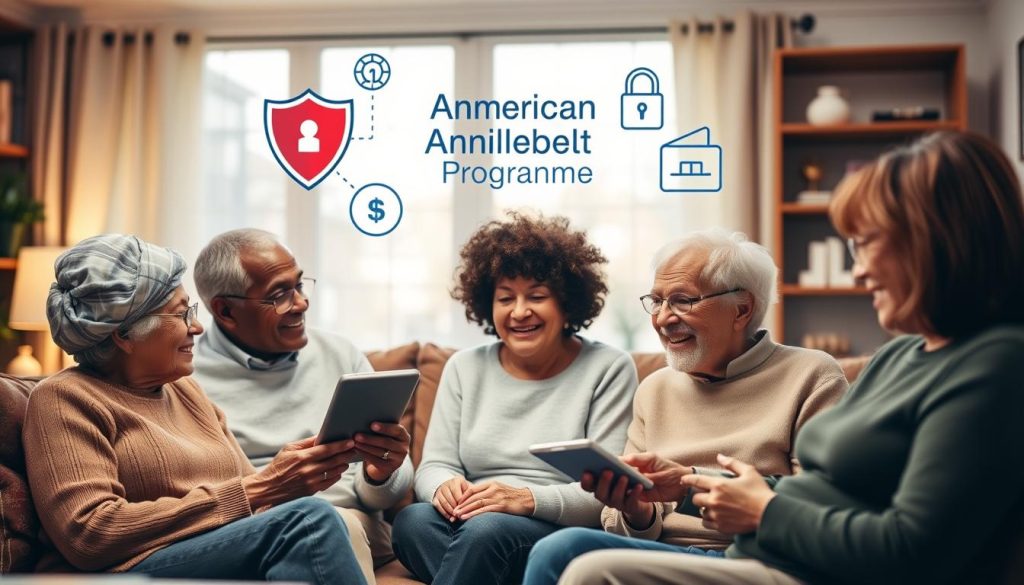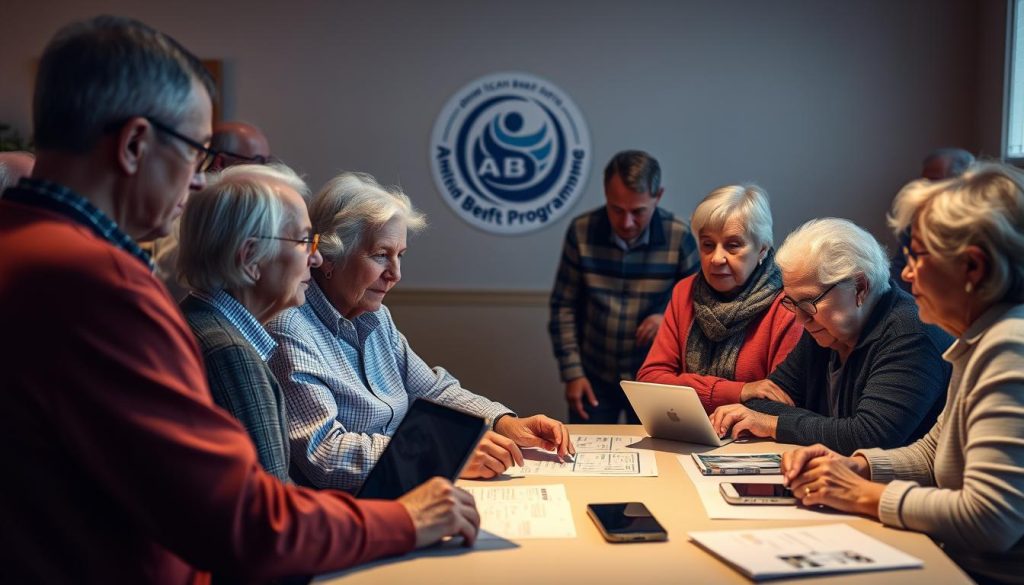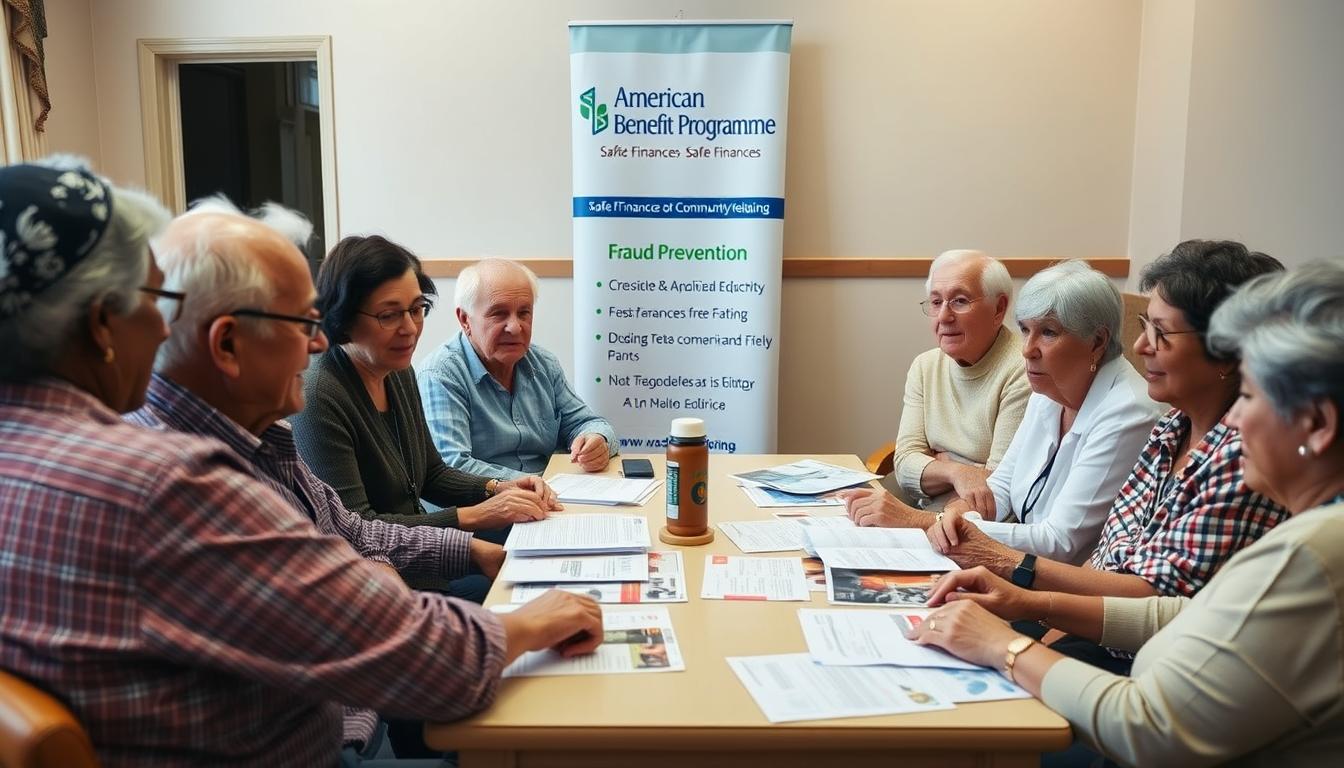Are your loved ones walking into traps set by scammers aimed at their age group? Telemarketing fraud alone makes $40 billion each year1. Because of this, we must act fast to protect our seniors2. This guide will help avoid scams and keep their money safe.
Key Takeaways
- Understanding the diversity and magnitude of senior scams is crucial for effective prevention.
- Trust and willingness to help often make seniors prime targets for fraudsters.
- Proactive measures, such as regular financial reviews, can prevent elder financial abuse.
- Community resources play a pivotal role in educating seniors about potential scams.
- Technology can be a valuable ally in protecting against financial exploitation.
Understanding Senior Fraud: The Scope of the Problem
Senior citizens, especially those over 65, face a high risk of fraud. This problem is big in today’s society. More than 63% of victims 55 and older often keep quiet. They don’t talk about it because they feel ashamed or scared3. Scammers use many tricks like fake Medicare, bad prescription drugs, and the grandparent scam3.
About 1 in 10 older Americans suffers from abuse annually. This amounts to $77.7 billion in fraud globally that targets the elderly4. Often, a victim knows the scammer well, which can make it hard to tell others about the abuse4.
It’s crucial to notice if an elderly person might be getting scammed. Look for sudden account changes, weird financial activity, or quick money requests4. By knowing what to watch for, we can better protect our seniors from these crimes.
Common Types of Frauds Targeting Seniors
In 2022, scams aimed at seniors were on the rise. Older people were tricked in various ways, leading to more than 88,262 fraud reports from those 60 and up. These scams caused huge losses of $3.1 billion, which is an 82.35% jump from before5. Telemarketing scams and phishing emails are common tactics used to steal personal info.
Scams where crooks pretend to be from the government or tech support are really harmful. In 2022, seniors lost over $724 million to these scams. That’s more than what other age groups lost combined5. The U.S. Senate Special Committee on Aging found around 8,000 elder fraud complaints in five years. This shows how serious the problem is5. By 2023, people aged 60 and over faced losses of about $3.4 billion from scams. This was an 11% rise from 20226.
Investment fraud, especially with cryptocurrency, has changed a lot. Losses jumped to $2.57 billion in 2022 from $907 million in 20215. That’s an increase of 183%. The average loss for seniors involved in fraud was nearly $34,000. Impersonation and tech support scams alone cost them $1.3 billion6.
To fight back, it’s key for older folks to stay aware and cautious. Knowing about common scams can help them avoid becoming victims. Staying informed is a top way to protect oneself from these scams6.
Senior Fraud Prevention: Recognizing Warning Signs
It’s crucial for seniors to know the signs of potential fraud. Being aware helps prevent identity theft and protect against scams. Tricksters use sneaky methods that need quick action.
Unusual calls or emails
Getting calls or emails without asking for them can be scary. They might ask for private info. Older people often get targeted by fake government workers, prize scams, and computer help frauds. Seniors should be careful not to share personal details unless they’re sure who they’re talking to. These odd messages might lead to big money losses.
Unexpected financial changes
Sudden changes in money matters are a big warning sign. Keeping an eye on unpaid bills, strange withdrawals, or unknown charges is key. For example, checks written to “cash” or bigger credit card debts could point to trouble. Each year, around five million older Americans face financial abuse, losing about $36.5 billion7. Catching and reporting these issues early can help get lost money back and keep seniors safe7.
| Warning Sign | Details |
|---|---|
| Unsolicited Calls | Calls from unknown numbers asking for personal information. |
| Emails from Unknown Sources | Strange emails requesting sensitive details or offering deals too good to be true. |
| Financial Transactions | Large withdrawals from savings or checks made payable to unfamiliar individuals. |
| Unpaid Bills | Bills that are not being paid on time, indicating possible financial mismanagement. |
| Unusual Spending Patterns | Increased expenditures on gift cards or uncharacteristic wire transfers. |
How to Safeguard Against Elder Financial Abuse
Protecting our elders from financial harm is very important. It’s the fastest-growing type of elder abuse today. We can fight this by choosing a trusted person and checking finances often.
Choosing a trusted contact person
Picking someone reliable to watch over finances hugely helps. This person should be a family member or a close friend. Talking often with this contact helps spot any strange actions. This adds more safety against scams. Sadly, the danger can come from both known people and strangers who trick elders8.
Regular financial reviews
Checking finances often is key to seeing abuse early. Elders should look at their credit reports to catch any fraud9. Watching for odd spending or changes in how money is handled is crucial. These are warning signs of abuse9. Helping with checking accounts and shredding personal papers are good steps for families9.

| Protective Measures | Description |
|---|---|
| Trusted Contact | A person who monitors financial activities and communicates regularly to ensure security. |
| Regular Reviews | Consistent assessment of financial statements and credit reports for suspicious activities. |
| Education | Understanding common scams and fraud tactics to better protect against them. |
| Open Communication | Discussing finances openly with family and friends to aid in fraud detection. |
Using these steps doesn’t just fight fraud. It also makes a safer financial world for our elders98.
Building Financial Literacy Among Seniors
It’s vital to increase financial literacy among seniors to stop senior fraud. Older people often lose $28.3 billion a year to scams, says AARP10. Teaching them about managing money helps them fight fraud better. Programs that teach financial skills give seniors the tools to make smart money choices.
Learning how to manage money and spot scams is key. Apps like You Need a Budget and Every Dollar help with budgeting10. Experts like Certified Financial Planners offer advice tailored to seniors’ needs10.
The CFPB has a questionnaire online to check money attitudes and readiness for the future. This builds confidence11. Learning about finances helps prevent scams and boosts life quality for seniors11. Seniors with good financial knowledge tend to be healthier, showing how money smarts affect overall well-being10.
Resources for Seniors and Caregivers
Seniors and caregivers need good resources to fight senior scams and elder fraud. There are programs and tools to help them learn about financial safety. This helps them to stay safe from scams.
Money Smart for Older Adults Program
The Money Smart for Older Adults Program is made by two groups. The Federal Deposit Insurance Corporation and the Consumer Financial Protection Bureau made it. It teaches seniors how to spot scams and weird things that might not be right. This makes them safer with their money. This program is a big help in fighting fraud against elders.
Consumer protection tools and guides
There are a lot of resources to help seniors and their caregivers. Some programs help with legal issues from elder abuse. The National Elder Fraud Hotline lets seniors report fraud and get help12. Banks, like Bank of America, work to keep customers safe by adding trusted contacts13. Events that make people aware of scams also help protect seniors.
Financial Institutions’ Role in Fraud Prevention
Financial places work hard to find and stop elder fraud. They do more than just handle money. They protect older people’s money safety. From June 15, 2022, to June 15, 2023, there were 155,415 reports of Elder Financial Exploitation (EFE). This shows we need strong actions to stop this14.
They start things like alerts and programs to fight fraud. They work with local groups to spot fake transactions. This helps everyone keep an eye out. The Senior Safe Act in 2018 helps this cause. It says financial advisors can report fraud without getting in trouble. This shows trust and teamwork are key15.
Teaching staff to see fraud signs is key. Thanks to BankSafe, trained workers report scams five times more. This lowers the chance of money loss, especially for older people15.
Because of these steps, banks reported about 15,993 EFE things every month from June 15, 2023, to January 15, 2024. This is good news. It means banks are getting better at keeping older adults safe14.
| Initiative | Year Implemented | Impact |
|---|---|---|
| Senior Safe Act | 2018 | Protects advisers reporting fraud |
| BankSafe Initiative | 2019 | Helped prevent nearly $1 million in fraud losses |
| FINRA Rule 4512 | 2018 | Requires addition of trusted contacts for clients |
When financial institutions teach their staff and join hands with local groups, they do a lot for senior cyber scam protection. About $27 billion in shady EFE activities were reported. This means we must always look for better ways to stop fraud14.
Preventing Senior Scams with Technology
Technology helps fight scams against seniors. In 2023, half of all fraud reports in the U.S. were from seniors. They lost nearly $3.4 billion, an increase from 202216. It’s key to use things like two-factor authentication and identity theft protection.
Staying safe online can really help. If seniors haven’t lost money, they’re likely to report fraud. It’s so important to know the scam signs17. Like weird calls or emails. Families talking about this can help seniors a lot18.
Tech support scams are a big problem for those over 60 in 2023. Keeping passwords strong and checking for “https://” on websites helps16. Also, not using wire transfers or gift cards for payments can prevent scams17.
| Security Measure | Benefit |
|---|---|
| Two-Factor Authentication | Provides an extra layer of security against unauthorized access. |
| Secure Passwords | Reduces the risk of accounts being hacked. |
| Identity Theft Protection Services | Monitors for unauthorized activity and alerts you. |
| Education on Scam Recognition | Empowers seniors to identify and report scams effectively. |
| Safe Online Practices | Minimizes the risk of falling victim to phishing and fake websites. |
Creating an Emergency Plan for Financial Compromise
It’s very important for seniors to have an emergency plan for scams. These scams hurt a lot of people every year19. Seniors might not tell anyone about these scams. They might be scared or confused19. To keep safe from these scams, knowing the signs is key, like weird bank activities19.
Here are key elements to include in an emergency financial plan:
- Verifying Financial Institutions: Always confirm that financial institutions are legitimate and trustworthy.
- Creating a Communication Plan: Establish an open communication path with family members or trusted individuals.
- Knowing Whom to Contact: Have a list of contacts for immediate support, including financial advisors or local consumer protection agencies.
To plan well, use resources and templates for these emergencies. This helps families be ready for scams. It’s very important to know about common scams. Scams that trick seniors are still happening a lot20. Preventing these can stop big money losses. In 2020, people over 60 lost more than $966 million20.
Seniors should keep their money, personal information, and important papers safe19. Working with trusted helpers and setting up a power of attorney is wise. This means they have someone they can trust to help them19. Building trust with care professionals is another way seniors can stay safe21.
Community Initiatives for Elder Fraud Detection
Local groups are key in fighting elder fraud and helping with senior scam prevention. They run programs to teach and support older people about scams. These workshops are great for learning and sharing stories.
Last year, more than 357,500 seniors got help from over 5,540 VOCA groups22. These programs use flyers to spread the word on how to spot scams23. More scams are being reported thanks to these community efforts23.
Working together helps build a strong support network. In 2019, the Department of Justice gave $4.9 million to 13 groups for elder abuse projects22. Each meeting helps seniors learn how to stay safe.
To fight elder fraud, we need everyone’s help. Working in networks boosts the fight against these crimes. Local and national groups work together to help as many seniors as possible.

Visit this detailed guide for more info on community efforts. It helps seniors and their families protect against scams.
Government and Nonprofit Resources for Protection
Many groups work hard to protect the elderly from financial scams. The National Council on Aging (NCOA) is key. It gives older people tips to stay safe from fraud. It also shows which scams are most common24.
Adult Protective Services (APS) helps victims in many ways. They might offer at-home care, food, or legal help. This builds a safety net for those hurt by money scams25. Police at all levels fight against elder abuse and money theft. They have special teams for these important cases25.
Local police, community groups, and the elderly work together. They do this through Triads, set up by the National Sheriff’s Association. This raises awareness about elder abuse25. Also, prosecutors work with APS and police. They take abusers to court to help the victims25.
Legal aid gets vulnerable seniors the help they need at little or no cost. This support helps them deal with the results of financial abuse25. The Eldercare Locator connects seniors and their families with many services. Call 1-800-677-1116 for help24.
The Consumer Financial Protection Bureau and the Federal Deposit Insurance Corporation have resources to help. These include guides and the “Money Smart for Older Adults” program. They improve understanding of financial abuse24
Finally, the National Center on Elder Abuse (NCEA) and the Women’s Institute for a Secure Retirement (WISER) provide a lot of info. They have resources to stop scams and advice on dealing with financial issues older adults face24.
Conclusion
Keeping our older folks safe from scams is very important. Every year, lots of them lose money to these tricks. We must know how to spot scams and protect them26. People call this issue the ‘silver tsunami.’ It shows we need to pay more attention and stop elder money abuse27.
We looked at different scams aimed at seniors. Staying alert, checking finances often, and picking trusted helpers are key. These steps help keep seniors safe from tricks26. The Do Not Call Registry and tips from the US Department of Housing and Urban Development are great tools too.
Let’s help the seniors we know by sharing what we’ve learned. Using these resources can make them stronger against scams. Teaching our older loved ones about money safety is very important. It gets them ready to defend themselves2627.
Source Links
- Seniors Guide to Fighting Fraud
- Protecting Older Adults: A Guide to Senior Scams – Park View Federal Credit Union
- Fraud On the Elderly | FAU Business
- Elder Fraud: Prevalent & Preventable
- Top 5 Scams Targeting Seniors
- What Are the Top Payment Scams Affecting Older Adults?
- Fraud & Older Adults: Spot the Warning Signs
- Safeguard Your Loved Ones: Combatting Elder Financial Exploitation
- Protect Older Americans from Financial Exploitation
- Promoting Healthy Aging During Financial Literacy Month – Rheinhardt & Bray PC
- Senior Fraud Prevention Resources
- Elder Justice Initiative (EJI)
- Financial Protection for Aging Adults & Caregivers
- FinCEN.gov
- How Banks and Brokers Can Help Stop Elder Fraud
- Elderly scams: Types and tips to help protect seniors
- Staying Safe Online: Tips for Older Adults
- Protecting Seniors from Scams, Fraud, and Misinformation – UDS Foundation
- 5 Ways to Prevent Elder Financial Abuse | Gate City Bank
- Elder Scams and Senior Fraud Abuse – HelpGuide.org
- Threat Intelligence Product: Protecting Vulnerable Adult and Senior Investors
- OVC Elder Fraud & Abuse Initiatives | Office for Victims of Crime
- How to expand your elder fraud prevention network | Consumer Financial Protection Bureau
- Elder Fraud and Financial Exploitation
- Elder fraud prevention and response network stakeholders | Consumer Financial Protection Bureau
- Fraud Against the Elderly | FDIC.gov
- What is Elder Financial Fraud and How to Prevent it

Leave a Reply